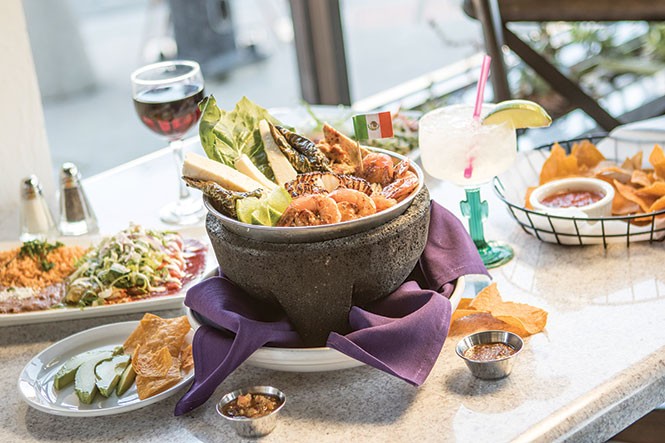
Hang around and eat enough in Salt Lake City, and you begin to see ghosts. To wit, the old stand-alone building at 209 W. 200 South, which was once home to a sushi restaurant, Ginza. It was taken over by restaurateur Carlos Rodriguez after Ginza closed, and he opened the popular La Fountain restaurant. The Mexican eatery was always a bit cramped, but I was bummed a few months ago to see that the doors were permanently shuttered. La Fountain offered good Mexican fare and great service at wallet-friendly prices. However, with the wrecking ball seemingly on the horizon—the block is virtually vacant—Rodriguez moved on.
Thanks to City Weekly's intrepid, longtime circulation manager, Larry Carter, I learned that La Fountain was to be rebranded and rebooted in a bigger space, just a block or so west of the original location. Now called Chile-Tepin, Rodriguez' new space is large and airy, and located in the Crane Building on the corner of 200 South and 300 West, formerly home to the Vietnamese restaurant Café Trang (after Xiao Li Chinese eatery vacated it). I told you there were ghosts.
Where does the name come from? Chiltepin chiles are tiny red peppers that pack a whopping punch. Known by some as "Mexican Viagra," and also as bird's eye peppers, this diminutive North American native pepper weighs in at 50,000-100,000 units on the Scoville heat scale. That's up to 40 times hotter than a jalapeño. If you're averse to spicy food, however, don't stop reading. There are plenty of flavorful but mild dishes to enjoy at Chile-Tepin.
Promptly seated by a friendly hostess on a recent Wednesday night, I was surprised at how bustling the restaurant was. Most of the tables in the large, open dining room were full, and folks seemed to be having a merry old time. No sooner were we seated than water glasses were filled and gratis chips and salsa arrived. I thought, if this is any indication of what's to come, it's going to be a good night. The chips have an unusual orange hue, but are homemade and delicious, accompanied by a rich, dark red salsa that's about as perfect as it gets. And they were replenished frequently.
Perusing the drink list, I honed in on a glass of shiraz ($5) while my wife opted for a Sauza Plata margarita ($6)—one of seven margarita variations available, not counting flavored options like strawberry, peach, mango and pineapple. The Sauza Plata was outstanding; easily the best margarita I've tasted for that price. Our dinner guest—a wine-industry expert who'd just returned from a taxing week-long "wine camp"—opted to stick with cold water.
Running down the menu, my eyes quickly zeroed in on the word molcajete. For most of my life, I knew it to be a Mexican stone mortar and pestle (sometimes made from porous lava rock), derived from the Nahuatl word molcaxitl. It's used for grinding corn, spices, chiles, garlic and just about any other foods that can be ground or mashed. Many restaurants use them to serve guacamole or salsa in.
Somewhere along the line—I first began seeing them about 15 years ago—molcajete went from being not just the stone kitchen tool, but also the name for a dish in which the tool itself became a serving vessel. At Chile-Tepin, the bowl is brimming with a "stew" of scrumptiousness: grilled chicken (pollo asado), strips of carne asada, shrimp, nopales (cactus strips), charred jalapeños, onions and rectangles of Oaxacan cheese the size of Jenga blocks—all simmered in a lava-hot tomatillo sauce ($24.99). The menu says it serves two. Well, maybe as a main course. As an appetizer, it served the three of us with leftovers. It also comes with a choice of warm corn or flour tortillas, a heaping pile of Mexican rice, and bowls of outstanding smoky-flavored soup with pinto beans.
Heat seekers would do well to order the camarones a la diabla ($14.99). It's a devilishly spicy and vibrant dish of tender, plump shrimp in a chiltepin-infused tomato sauce, served with white rice and a side salad of shredded greens and chopped tomatoes topped with crumbled queso fresco. A carnitas plate ($12.99) with excellent refried beans, Mexican rice, guacamole and pico de gallo fell a little short due to the dryness of the shredded pork. I felt like I'd gotten the scrapings from the bottom of the carnitas pan. The flavor, still, was outstanding.
An order of carne asada ($13.99) featured a generous portion of marinated, thin-sliced, charred beef with the same accoutrements as the carnitas, plus a roasted jalapeño pepper and lime wedges. Throughout the evening, service could not have been more friendly or professional. My overall feeling was that Carlos Rodriguez and Chile-Tepin have thrown down the gauntlet and raised the stakes regarding Mexican food in downtown Salt Lake City.
As we walked away from our meal satiated, my wine geek friend—who is normally quite articulate—said, "I am going to eat the shit out of this place!" Agreed.